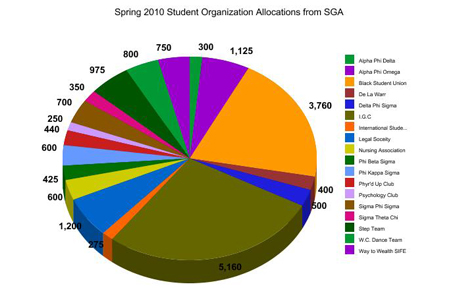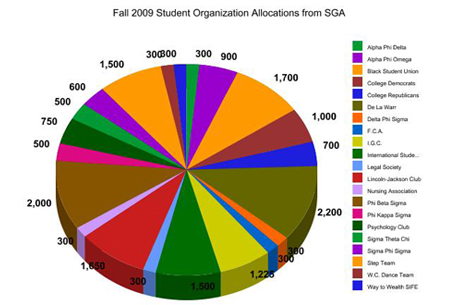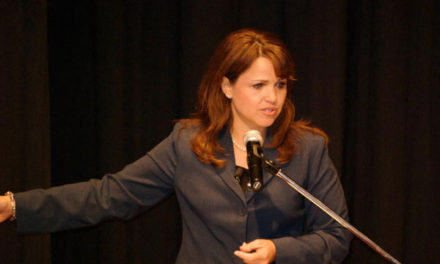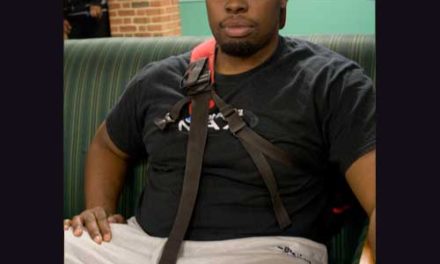By Kim Manahan (Whetstone Staff Writer)
SGA
Student organizations only got about a third of the money they requested from the Student Government Association this semester, said Ann Wright, treasurer of the SGA.
The organizations had requested $52,300. The SGA gave them $18,000.
The Black Student Union (BSU) and Inter-Greek Council (IGC) received the most.
New financial guidelines were approved by the SGA congress last semester.
Budget requests must provide as much information as possible about the event, said Beth Fisher, director of student activities. “SGA does research of the actual costs so organizations don’t make up numbers.â€
When organizations put in their requests, they need fundraisers, Wright said.
Section 2-v. of SGA’s Financial Procedures rules say that “each club/ organization that requests money must have a fundraiser on their request form in order to be allocated funds.â€
Organizations must explain how the money they want will benefit the college, Fisher said.
“SGA should not pay for the whole event, [the organizations] should fundraise too,†Wright said. BSU’s requests included the annual block party and T-shirts, a bowling fundraiser, movies, and a trip to a wax museum. They received $3,760 this semester.
The IGC, which received $5,160, requested money for Greek recruitment, Wishfest, “Kiss Cancer Goodbye,†and the Relay for Life fundraiser. For the BSU block party and IGC’s Wishfest, both budget requests included money for inflatables, novelty items and T-shirts.
Inflatables cost up to $3,000, Wright said. IGC had asked $4,000 to rent several of them, so will have to raise the money for the rest.
“Historically, [BSU] has been the ones that get the highest budget because they’ve been the most active,†Fisher said.
The Legal Society, which received $1,200, takes a trip to the American Bar Association in Chicago.
The Step Team got $975 for a fashion show, uniforms and events that they co-sponsor.
The SGA considers the involvement of the organization when it decides on the money it gives, Wright said.
Organizations’ budgets roll over from fall to spring, but do not between spring and fall. “[The leftover money] goes back into the [SGA] budget for the following semester,†Fisher said.
Student Activity Fees
For the spring 2010 semester, 1,320 students paid $265 each in student activities fees, making the total amount distributed $349,800.
The activities fees are distributed among the Student Activities Board ($59,400, or 17 percent of the total), the SGA ($59,400, 17 percent), student center financing ($95,700, 27 percent), health center financing ($66,000, 19 percent ), Eukaria ($15,840, 4.5 percent), The Whetstone ($13,200, 4 percent), the Underground ($13,2000, 4 percent), student capital improvement ($19,800, 5.6 percent), and student activities programming ($7,260, 2 percent).
The Whetstone
Each semester, The Whetstone receives $10 from each student in activities fees, or about 4 percent of the total each student pays in student fees.
The college newspaper became independent of SGA funding in 2006 after a dispute with a former college administration.
Patrice Wilding, former editor and a Wesley graduate, said that when she joined The Whetstone in the fall of 2005, there was no funding, and the only money that was given to the paper came through the Media Arts Department.
The staff fought for funding, but the question of to whom the paper would answer came up.
“The administration wanted the paper to answer to them directly,†Wilding said. “[They] wanted to see stuff before it was printed. It was complete conflict of interest to answer to someone we were writing about.â€
When Wilding wrote for The Whetstone, the SGA president had called the paper a “tabloid†following articles published about an alleged rape on campus and a shooting at a local nightclub.
The Whetstone gained its independence from both the administration and student government after a faculty vote.
After the paper won the right to an independent budget, for a couple years, the Whetstone had no full-time advisor, and a surplus accumulated.
During the fall of 2008, the newspaper got a full time adviser, Professor Victor Greto, who began to implement improvements, including three new Macintosh computers. This year, Greto took three students – two from the print edition and one from the new Whetstone online edition – to a conference in Phoenix, Ariz.
The money from The Whetstone budget also is used for WXSTREAM, Wesley’s online radio station, for The Whetstone Online.
The money also covers printing costs – each issue of The Whetstone costs about $600 to print – conference fees, subscriptions, cameras and video equipment and the fees associated with Internet radio.
“I want to build up The Whetstone to be a premier college newspaper, and the only way to do that is to educate the reporters and editors of the latest techniques and to have the latest equipment,†Greto said.
Recently, Greto released $30,000 from the surplus to Dr. William Johnston, Wesley College president.
“In essence, there was an accumulation of funds over several years and Professor Greto agreed that a portion could be returned to the general budget,†Johnston said. “The funds that were transferred have gone into the budget to support the general operations of the college.â€
There is currently about $35,000 remaining in The Whetstone and WXSTREAM’s budget.





